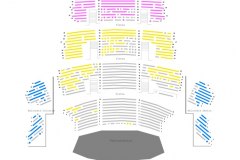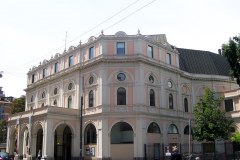Ezio Greggio, A Life on the Screen
Mo | Tu | We | Th | Fr | Sa | Su |
Theatrical Show
Ezio Greggio in A Life on Screen, 40 Years of TV, Cinema, and Italian History, will be in Milan, Teatro Dal Verme, on February 21.
Ezio Greggio, a myth of TV and cinema… finally arrives at the theater! Ezio Greggio, a beloved figure among the public, brings to the stage a summer version of a show destined for the great Italian theaters. In this “One Man Show,” the audience will find the history of Italian TV from yesterday to today through his incisive monologues, parodies of famous TV and political figures, and some of his most well-known numbers, such as the Asta Tosta with the legendary painting of Master Teomondo Scrofalo. With the aid of a large LED wall screen, Ezio, with his satire and his sharp and ironic personal style, jokes and entertains the audience, discussing television, politics, sports, and Italian society from yesterday to today. He then shares hilarious anecdotes of extremely funny events and encounters he has had in Italy and the United States. The screen will feature unexpected surprises, funny clips, and unforgettable moments from his career. There will be live audience engagement through many of his numbers, most of which are absolutely unexpected. A different show, 90 minutes live, in which Ezio Greggio, a true “N.1” on stage with the charm that sets him apart and the technical support of a high-level professional group, confirms himself as a master of ceremonies, a favorite of the public, and an unpredictable artist who has traversed—and continues to do so—the history of Italian entertainment. Ezio Greggio, a myth of TV and cinema… finally arrives at the theater! Actor, showman, director, journalist, writer, an undisputed protagonist at Mediaset of Italian television, with cult programs such as “Drive In,” “Paperissima,” “La sai l’ultima,” “Veline,” and “Striscia la notizia,” the popular satirical news program he has hosted since its first episode in 1988, and which he has presented for over 4,000 episodes to date. In cinema, over 40 films, TV films, and series, including Yuppies, Vacanze di Natale, Anni 90, Monte Carlo Gran Casinò, Infelici e Contenti, Anni 50, Un Maresciallo in Gondola, Benedetti dal Signore, Il Silenzio dei Prosciutti, Selvaggi, Lockdown all’italiana, Il Papà di Giovanna, for which he won the Nastro d’Argento, the Globo d’Oro, and the Premio Flaiano.
Program and cast
Teatro dal Verme
The Teatro Dal Verme is a theatre in Milan, Italy located on the Via San Giovanni sul Muro, on the site of the former private theatre the Politeama Ciniselli. It was designed by Giuseppe Pestagalli to a commission from Count Francesco Dal Verme, and was used primarily for plays and opera performances throughout the 19th and early 20th centuries. Today, the theatre is no longer used for opera, and is a venue for concerts, plays and dance performances, as well as exhibitions and conferences.
The original 3,000-seat theatre, surmounted by a large cupola, was constructed in the traditional horseshoe shape, with two tiers of boxes and a large gallery (or loggione) which alone contained more than 1000 seats. It opened on September 14, 1872 with a production of Meyerbeer's Les Huguenots and soon established itself as one of Italy's most important opera houses. During its "golden years", the theatre saw the world premieres of Puccini's Le Villi (May 31, 1884); Leoncavallo's Pagliacci (May 21, 1892) and I Medici (November 9, 1893); and Cowen's Signa (November 12, 1893). It also saw the Italian premiere of Lehár's The Merry Widow (April 27, 1907).
By the 1930s, the theatre was mainly being used as a cinema. It was then severely damaged by American aerial bombardment during World War II, after which its magnificent central cupola, which had survived the bombing, was stripped of all its metal parts by the occupying German army. It was partially rebuilt in 1946, and for a period in the 1950s it was used for the performance of musicals. It then reverted to a cinema and a political conference hall.
In 1991, the theatre's interior underwent a major restructuring and renovation project which was completed in 1998. It now has a large modern auditorium, the Sala Grande, with 1420 seats, a smaller performing space known as the Sala Piccola, with 200 seats, and a space for exhibitions and conferences, the Sala Terrazzo. Since September 2001, it has been administered

 EN
EN DE
DE IT
IT FR
FR ES
ES RU
RU JP
JP RO
RO
 Seating plan
Seating plan 
